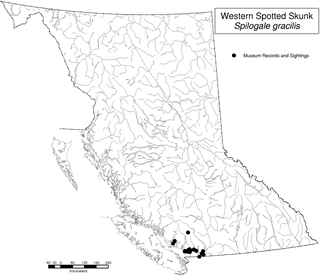Western Spotted Skunk
Family: Mephitidae
Species Information
|
Status Information
|
BC Ministry of Environment: BC Species and Ecosystems Explorer--the authoritative source for conservation information in British Columbia. |
Taxonomic and Nomenclatural Links
Additional Range and Status Information Links
Additional Photo Sources
Species References
|
Carey, Andrew B. and Janet E. Kershner 1996 Spilogale gracilis in upland forests of western Washington and Oregon. Northwestern Naturalist 77: 29-34. Hatler, David F., David W. Nagorsen and Alison M. Beal. 2008. Carnivores of British Columbia. Royal BC Museum Handbook, Victoria. Molly M. McDonough, Adam W Ferguson, Robert C. Dowler, Matthew E. Gompper, and Jesús E. Maldonadoe. 2021. Phylogenomic systematics of the spotted skunks (Carnivora, Mephitidae, Spilogale): Additional species diversity and Pleistocene climate change as a major driver of diversification. Molecular Phylogenetics and Evolution. July 2021. Montana Natural Heritage Program. Western Spotted Skunk — Spilogale gracilis. Montana Field Guide. Montana Natural Heritage Program and Montana Fish, Wildlife and Parks. Available online.
Wikipedia. 2011. Western Spotted Skunk page. Available online. |
